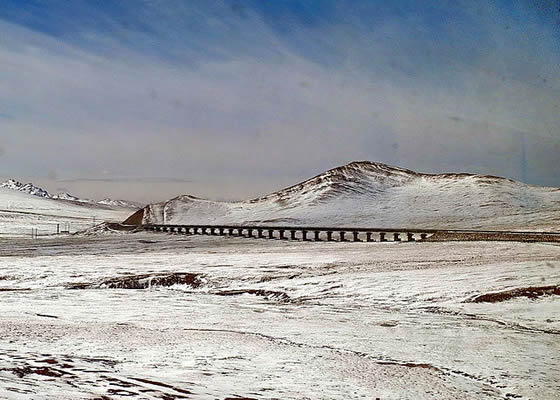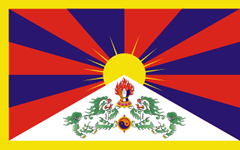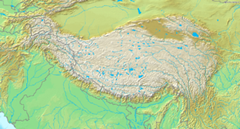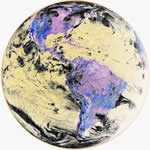Om Mani Padme Humm!
Tibet: A Diamond in the Lotus
By Brook & Gaurav Bhagat

The rooftop of the world, the land of snows… with an average elevation of 4000 meters (over 13,000 feet), the Tibetan Plateau is the highest and largest plateau on earth. The plants and animals there are unique-- the snow leopard, Tibetan antelope, Tibetan gazelle, Bengal tiger, wild yak, blue sheep, brown bear, and black-necked crane, to name a few. Visitors to Tibet before 1950 compared it to East Africa, with vast herds of large mammals roaming free through the mountains. Today, precious few remain.
But although the flora and fauna are diverse, the extreme climate has allowed only a relatively small number of them to flourish—species that have been able to adapt to the thin air, low temperatures, intense radiation, and strong winds. The most recent research indicates that about 13,000 vascular plants and 1200 species of vertebrates have been identified: 678 species of birds, 206 mammals, 83 reptiles, 80 amphibians and 152 fish. Of these, 40 plants and 141 animal species are considered to be endangered.
While this picture may seem rich—and indeed it is—these numbers are actually very low when looked at on a global scale. This ecosystem is the polar opposite of, for example, a South

“Because of its high elevation, the ecosystem here is extremely fragile," said Dawa Tsering, who heads the World Wildlife Fund’s China Program Office in Lhasa. “Once damaged, it is extremely difficult to reverse."
The major threats the region faces are grassland degradation and deforestation, poaching and the illegal trade of animal products, destruction of habitat due to urbanization and mining, and air pollution. Because of the elevation, the air is thin and more susceptible to toxic fumes.
“The sale of souvenirs and other products made from endangered species is growing due to tourist consumption, and is increasing pressure on local biodiversity," Tsering said. “Tourists can make a difference simply by not purchasing these products."
Tibet is the last remaining refuge of the Bengal tiger in China. WWF and other non-profits plan to distribute pamphlets, asking visitors not to buy illegal products made from endangered species like tigers and Tibetan antelopes. The soft underbelly fur of these antelopes is made into shahtoosh shawls, which fetch high prices on the black market.
“International and local laws have guaranteed that killing wild tigers and other protected species for their parts isn't legal  anywhere in the world," said Dr. Xu Hongfa from TRAFFIC's China Program. “But the killing of these animals will continue until the demand for buying them stops."
anywhere in the world," said Dr. Xu Hongfa from TRAFFIC's China Program. “But the killing of these animals will continue until the demand for buying them stops."
“Integrating the needs of local development with conserving Tibet's biodiversity is in need of urgent attention," Tsering said.
China invaded Tibet in 1949; under communist occupation, Tibet has suffered loss of life, freedom and human rights. In March 1959, the Tibetans rose up against them, but were unsuccessful. The Dalai Lama was forced to escape into exile in Dharmshala, India, followed by 80,000 Tibetans. It is from here that the Dalai Lama heads the Tibet Government-In-Exile.
When a country is taken by force, and brutally occupied, and its people are regarded as little more than an impediment to another end, without basic rights, what chance can that country’s plants and animals have? And do we have the right to concern ourselves with flora and fauna when human beings, perhaps some of the most beautiful and peaceful human beings on this planet, are also nearing extinction?
It is not necessary to choose. For thousands of years the Tibetan people have lived in harmony with their ecosystem and been a part of it; therefore, their struggle to survive must be included in a discussion of the destruction of that ecosystem.
Tibet is also the only nation in the world that has recognized meditation as essential to life, and has made the search for truth and the awakening of personal consciousness an undisputed priority in its culture and religion. In the words of Osho, a contemporary enlightened master:
“Nowhere has such concentrated effort been made to discover man's being. Every family in Tibet used to give their eldest son to some monastery where he was to meditate and grow closer to awakening. It was a joy to every family that at least one of them was wholeheartedly, twenty-four hours a day, working on the inner being. They were also working but they could not give all their time; they had to create food and clothes and shelter… but still every family used to give their first-born child to the monastery.
“And we think the world is civilized, where innocent people who are not doing any harm to anybody are simply destroyed. And with them, something of great importance to all humanity is also destroyed. If there were something civilized in man, every nation would have stood against the invasion of Tibet by China. It is the invasion of matter against consciousness. It is invasion of materialism against spiritual heights.
“If humanity were a little more aware, Tibet should be made free because it is the only country which has devoted almost two thousand years to doing nothing but going deeper into meditation. And it can teach the whole world something which is immensely needed" [Om Mani Padme Humm].

Tibetan Buddhism belongs to the Mahayana branch of Buddhism, which emphasizes compassion as the ultimate goal of meditation, rather than just enlightenment. Recent scientific studies show neurological proof that people who meditate actually feel more compassion for others, and are more likely to feel compassion for strangers.
“Emotionally, mentally and physically, all humans are equal and the same. We should take care of one another. It is good for us," said the Dalai Lama last month in India. His life and work embody compassion, laughter and love—although the Chinese insist it is a diabolically constructed illusion, and to possess even a photograph of him is illegal in Tibet.
At least 6,000 Tibetan Buddhist monasteries, nunneries and temples, and their contents have been destroyed since the Chinese invasion and during the Cultural Revolution. At least hundreds of thousands of Tibetans have been killed as a direct result of Chinese execution, imprisonment and torture; by some counts, including suicide and other indirect means of death, the number is over a million.
Perhaps because the Dalai Lama is both the religious and political leader of Tibet, China still regards Tibetan Buddhism as a threat. “Patriotic re-education" is their term for the torture of monks and nuns, who are forced to denounce the Dalai Lama, and repeat after them that “Tibet has always been part of China." Religious pilgrimages are restricted, or impossible, and Buddhist education is difficult or impossible for Tibetans now. Forced sterilizations and abortions are commonplace.
Since the turn of the century, China’s economy has been booming, and what they call their “Western Development Plan" in Tibet has been picking up steam. Key to the plan has been the Qingzang Railway project.

The 815 km section of the railroad from Xining, Qinghai to Gormo (Golmud in Chinese), Qinghai opened to traffic in 1984. Construction of the remaining 1,142 km section from Gormo to Lhasa could not be started until the recent economic growth of China. This section was begun in 2001, and completed in 2006. The cost to the Chinese Government was $3.68 billion.
Before he left office, the former President of China, Jiang Zemin, said of the Gormo-Lhasa railway, “Some people have advised me not to go ahead with this project because it is not commercially viable. I said this is a political decision" [New York Times, 10 August 2001].
This political decision is advantageous to China in many ways, and is one which will likely prove financially profitable. Tibet houses an estimated 4-5 billion tons in potential oil reserves; the railroad has greatly increased the efficiency of lumber, mining, and other government industries and projects as well.
Due largely to the railroad, Tibetans have become a minority in their own country.
 A recent report by the Washington-based International Campaign for Tibet says the completion of the railway has led to an influx of ethnic Chinese immigrants to the region, and that any economic gains from the improved transport links are largely limited to urban areas, rather than the countryside where about 80 percent of Tibetans live.
A recent report by the Washington-based International Campaign for Tibet says the completion of the railway has led to an influx of ethnic Chinese immigrants to the region, and that any economic gains from the improved transport links are largely limited to urban areas, rather than the countryside where about 80 percent of Tibetans live.
Foreign Ministry spokesman Liu Jianchao told reporters in Beijing that the railway has played a positive role in developing Tibet's economy and it has also strengthened its communication links with neighboring provinces.
“I believe the benefits of this project are obvious to all," he said. The rail link contributed to a 60 percent increase in the number of tourists visiting the region last year, according to a previous government report. This year, tourism is predicted to gross over $800 million.
In 1980, there were only 1059 visitors to Lhasa, and 95 percent came from abroad. Since then tourism has surged, and in 2002, an estimated 140,000 visited Tibet, with 1.22 million arriving in 2004, an increase of over 1,000 times the 1980 level. Ninety-two percent of the visitors are Chinese tourists.
But while the economy may have improved, the general economic status of Tibetans has not, as they are largely unskilled workers, and cannot compete with the skilled Han Chinese migrants. The ICT report says that the needs of the region's largely rural population are ignored by China's planners, and that Tibetans feel increasingly marginalized as their culture and rural way of life are slowly eroded. The Tibetan language is being systematically eliminated, and nomads forced into settlements.
The Chinese government itself has touted the Qingzang railway as a means of transport for troops, saying that not only will the railway improve the efficiency of the army, but the army will improve the efficiency of the railway (Xinhuanet, 10 December 2003). The railway has enabled rapid troop deployments and facilitated the expansion of the People’s Liberation Army, as seen in the recent crackdown. It not only has strengthened China’s grip on Tibet, but its strategic location may pose a threat to India as well, increasing instability in the region.
China has announced its plans to continue construction of the railroad all the way to Khasha, on the Nepalese border. It also plans to add six more lines to the railway which will run to other locations in Tibet.
The ICT report also states that China's policy of urbanization in Tibet, encouraged by the new rail link, is damaging its natural ecosystems. Over 46% of forests have been destroyed, which has led to increased soil erosion and siltation of rivers, creating major floods and landslides. Government lumber operations continue to cut at an unprecedented rate, and reforestation is generally neglected and ineffective. Rapid and widespread deforestation has life-threatening consequences for the hundreds of millions who live in the flood plains of the major rivers of Southeast Asia, many of which have their headwaters in Tibet. Clear-cutting also threatens the habitat of the rare giant panda, golden monkey, and over 5,000 unique plant species.
The demands of the fast-growing human population, construction of roads, mining, and poor grazing practices are degrading Tibet's grasslands as well. Huge factory farms are being developed, motivated by the need to feed the growing Chinese population and reduce the costly wheat imports. Traditional farming practices have maintained the ecological balance for centuries, but large-scale commercial agriculture may ultimately harm Tibet more than it helps.
Of far greater concern, however, are China’s nuclear weapons projects in Tibet. Today there are at least three nuclear missile launch sites there, and the number of actual warheads is unknown. The northern Tibetan Plateau was home to China's "Los Alamos"-- its primary nuclear weapons research and development plant. Tibetan nomads living in the area claim to have suffered illness and death. Their strange symptoms are consistent with radiation poisoning, indicating that nuclear waste may have been dumped on the plains nearby. The International Campaign for Tibet has published a ground-breaking report on the issue, entitled Nuclear Tibet.

The Tibetan Plateau is the source of almost all of Asia's major rivers: the Yellow River, the Yangtze, the Mekong, the Salween, the Indus, and the Yarlung Tsangpo, which downstream becomes the Brahmaputra. Contamination of these waterways, nuclear or otherwise, harms not only residents of Tibet, but potentially all those who drink from them—nearly half the world’s population lives downstream.
One such threat to the rivers is the mining industry. Tibet is rich in natural resources, and the unregulated extraction of borax, chromium, copper and gold is increasing rapidly. More surprising, however, is Tibet’s supply of lithium.
Chabyer salt lake, at an elevation of 14,400 feet (4,400 meters) is not only the largest lithium mine in China but also one of the three largest salt lakes in the world. Chabyer now makes Tibet the No. 1 area in the world in terms of prospective lithium reserves, according to the China Tibet Information Center. China is now the largest producer and consumer of lithium-ion batteries, found in everything from cell phones to computers and even hybrid cars.
The future of zero and ultralow emission vehicles depends on lithium, which is relatively scarce. Lithium is only the 33rd most abundant element on Earth. With Tibet in its hand, China is well poised to move into that future.
March 9th was the anniversary of the 1959 uprising, which recent protesters have been commemorating; but like their predecessors, this cry for freedom has met with little more than imprisonment, torture, and often death. The Chinese Government claims that 18 Han Chinese immigrants were killed in the Lhasa riots; but in their crushing response, over 140 Tibetans were killed by the Chinese. Countless others are still being held in prison, and may be executed as well.
On June 21, 2008, the Olympic torch came and went through Lhasa in about two hours. Tibetans live under virtual martial law, and were told not only to stay at home, but not to look out of their windows during the relay.
The decision by China to continue with the relay through Lhasa in light of recent events was a message to the world, that Tibet is their property and they fear no one. At the end of the relay, Zhang Qingli, the Communist Party secretary of Tibet, stood beneath the Potala Palace, the historic seat of the Dalai Lama. “Tibet's sky will never change, and the red flag with five stars will forever flutter high above it," Zhang said, according to Reuters. “We will certainly be able to totally smash the splittist schemes of the Dalai Lama clique."
This is the language of power, and people who use it know no other. Talks have just resumed between the Chinese and envoys of the Dalai Lama since the protests, but those talks had been going on since 2002 without progress. The Dalai Lama does not hope for independence, only autonomy for Tibet. Only time will tell if this round is any different.
As of now, 117 (121 by some counts) Tibetan monks and nuns have self-immolated in protest of the Chinese occupation.
The Dalai Lama spoke in Denver years ago—not about politics, but parenting, love, and other topics. When he asked for questions, one woman said, “What can we do about Tibet?"
The Dalai Lama was silent. “Just go and see it before it’s gone," he said at last. “It is a beautiful country."
Tibet—the plants, animals, water, air, people, religious heritage and the inner search itself— is our heritage as human beings; it is a part of us. Tibet is one of the real diamonds of this world… its freedom is our freedom, and whether the effort is futile or not, we must do anything and everything in our power to save it.
For more information, visit www.savetibet.org (International Campaign for Tibet).
Did you like the article? Subscribe here to our New Article Email Alert or RSS feeds.
Sharing is caring! Don't forget to share the love, and keep the conversation going by leaving a comment below:
Advertisement
